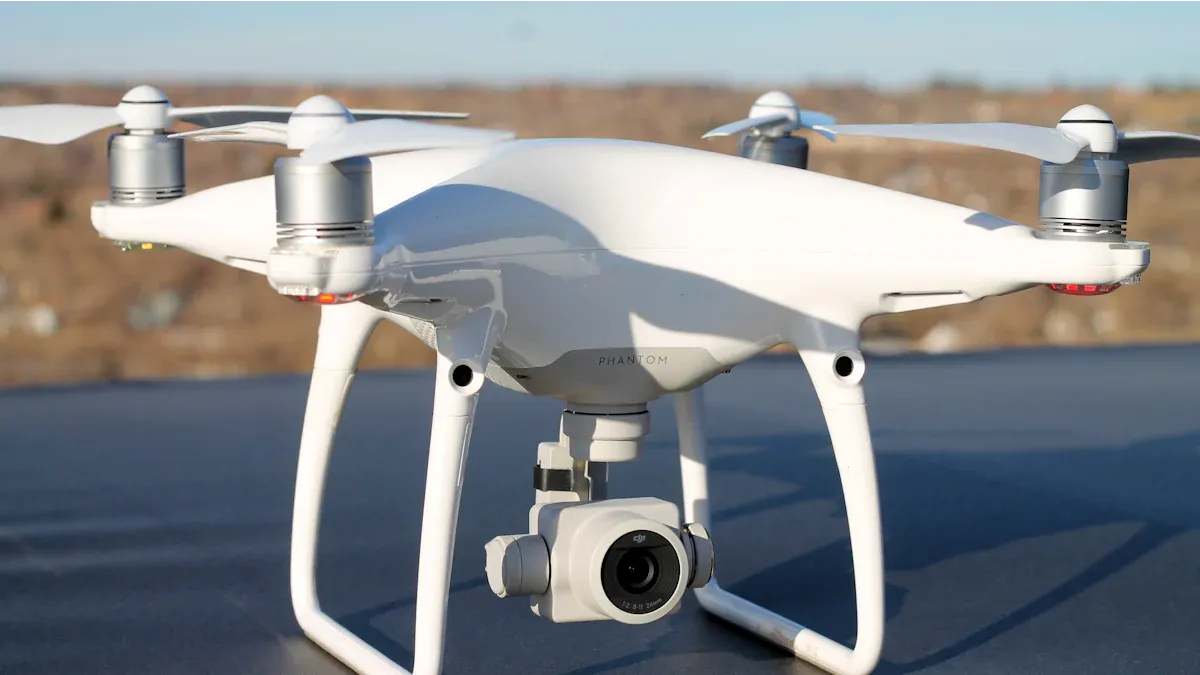
Ready to see which models are the best thermal drones for 2025? Here’s a quick look at your top choices:
DJI Matrice 350 RTK: Gives clear 640×512 thermal cameras, dual sensors, and can fly up to 55 minutes.
Autel EVO Max 4T: Has high-resolution thermal cameras, AI tools, and good obstacle avoidance.
DJI Mavic 3T: Small but strong with advanced thermal camera for drones, great for fast use.
Parrot Anafi USA: Has both thermal and visual cameras, NDAA compliance, and simple controls.
Experts say the best thermal drone has high-resolution thermal cameras, long flight times, and strong weather resistance. These features are in the top models, so they are great for inspection, search and rescue, or precision agriculture. The global market for thermal camera for drones is growing and is already $500 million in 2025. You now have more choices than ever for the best performance.
Key Takeaways
The best thermal drones in 2025 give clear heat pictures. They can fly for a long time. They also have smart tools like AI and can avoid things in their way.
Pick drones with high-resolution thermal cameras for sharp images. Dual thermal-visual sensors help you see more details and get better results.
Pick a drone that fits your work, like farming or inspections. You can also use them for search and rescue or firefighting. This helps you get the best outcome.
Always follow FAA rules and safe flying tips. Plan your flights, check your drone, and respect people’s privacy.
Use the buying guide and tables to help you pick a drone. Make sure it matches your needs, budget, and where you will use it.
Best Thermal Drones Overview
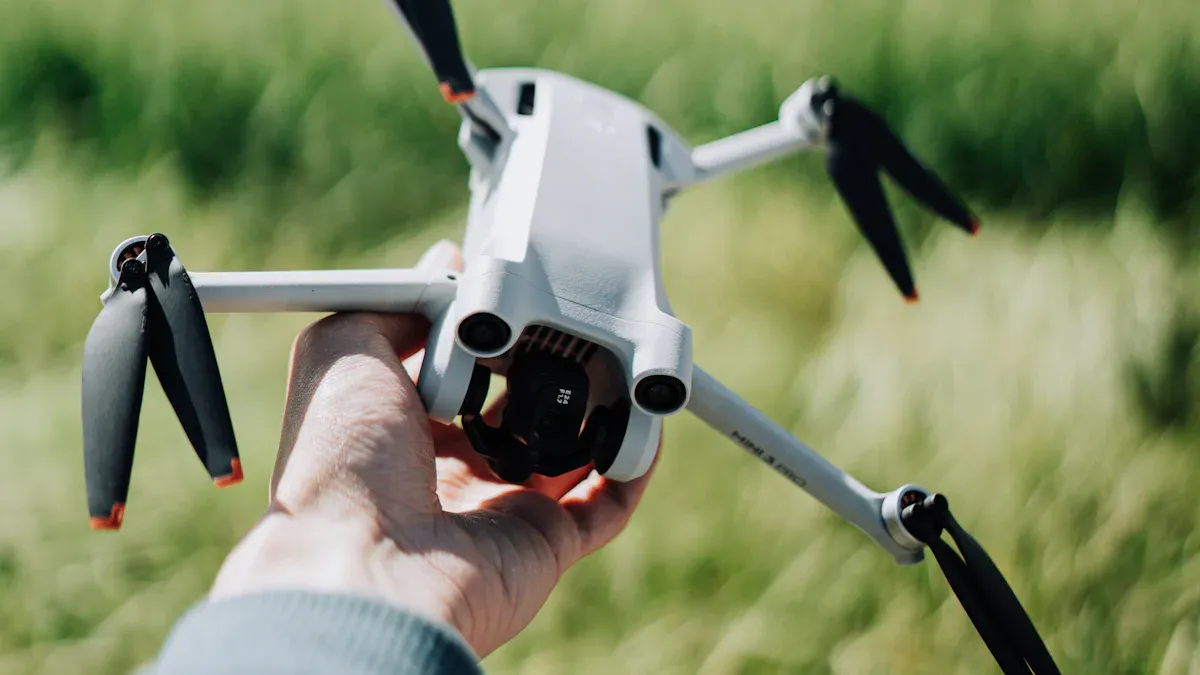
Top Models in 2025
If you want the best thermal drone, look for clear pictures, long flying time, and smart tools. Here are the top models people like in 2025:
DJI Mavic 3T: This drone is great for search and rescue, firefighting, and checking power lines. It has a 640×512 infrared thermal sensor and a 48MP camera. It can fly for 45 minutes. You get strong thermal imaging in a small drone.
DJI Matrice 4T: This new drone is good for public safety and utility work. It has a 640×512 infrared thermal sensor and can fly for 50 minutes. It uses AI tracking and is built tough. You can use it for hard jobs.
Autel EVO II Dual 640T V3: This drone has high-res thermal and visual cameras. It flies for 38 minutes and uses AI for smart missions. People use it for firefighting and farming.
Parrot Anafi USA: Police, military, and wildlife teams like this drone. It has a FLIR Boson infrared thermal sensor and 32× zoom. It keeps your data safe. You can carry it anywhere and set it up fast.
Autel EVO Max 4T: This drone is made for law enforcement and inspections. It has a 640×512 infrared thermal camera, an 8K camera, and a laser rangefinder. It also has 720° obstacle detection. You get strong sensors and easy flying.
Tip: The best thermal drones have both thermal and visual cameras. This helps you see heat and details at the same time.
Key Features at a Glance
The best thermal drone should have strong cameras, long battery life, and smart tools. Here is a quick look at how the best thermal imaging drones compare:
Drone Model | Flight Time (minutes) | Integration Features | |
|---|---|---|---|
DJI Matrice 300 RTK | 640 x 512 px | 55 | Multi-payload support, advanced AI, works in tough weather |
DJI Mavic 3 Thermal | 640 x 512 px | 45 | Hybrid thermal & optical cameras, RTK GPS, obstacle sensing |
Autel EVO Max 4T | 640 x 512 px | 42 | Hybrid sensors, laser rangefinder, GPS, encrypted storage |
Autel EVO II Dual 640T | 640 x 512 px | 38 | Dual thermal & visual cameras, smart tracking, 360° obstacle avoidance |
Parrot Anafi USA Thermal | Not specified | 26 | Lightweight, compact, 3-camera array (thermal + zoom + 4K HDR) |
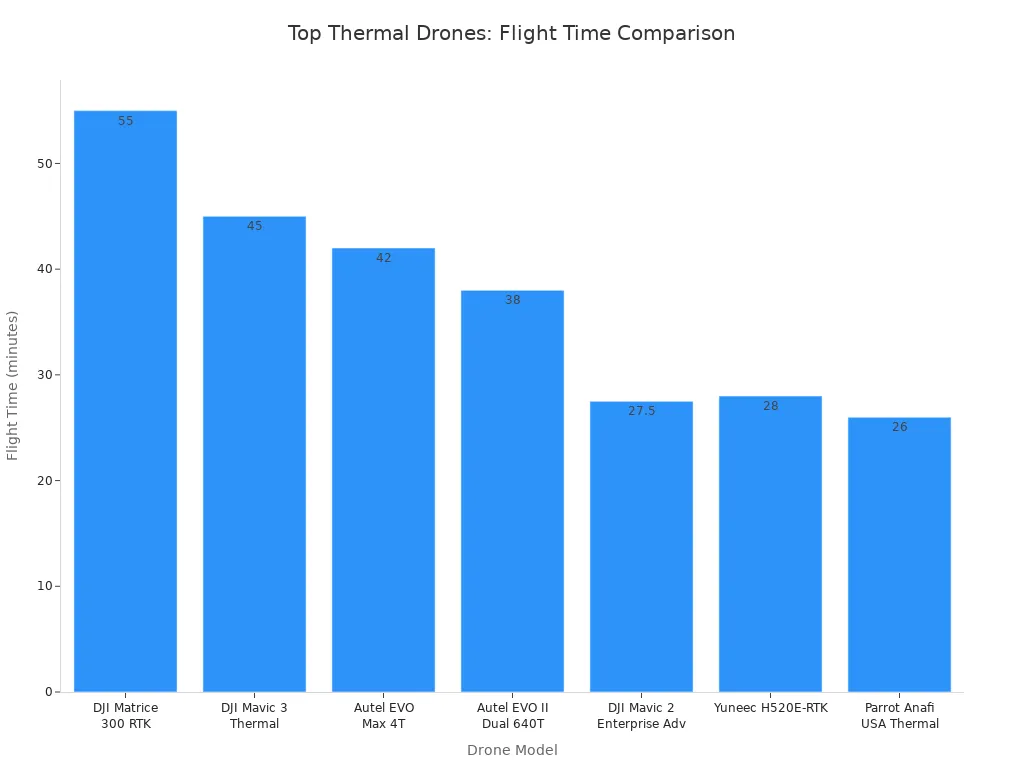
You can see the best thermal drones have high-resolution infrared thermal imaging and strong cameras. They also have smart features like AI and obstacle avoidance. These drones help you spot heat, find problems, and work safely. If you need thermal imaging for search and rescue, farming, or inspections, these drones give you the right tools.
Buying Guide for Thermal Camera for Drones
Picking the right thermal camera for drones can seem hard. But you can make it easier by looking at a few main things. Let’s talk about what is most important when you choose infrared cameras.
Sensor Resolution
You need a thermal camera resolution that matches your job. Most drone infrared sensors today are between 320×256 and 640×512 pixels. Higher resolution gives you clearer pictures. Lower resolution can still show temperature changes. This helps with search and rescue, checking crops, or finding leaks. Infrared sensors do not show as much detail as normal cameras. But they show heat differences, which is what you need.
Image Quality
Image quality in thermal cameras helps you find problems. High-resolution sensors let you see small issues from far away. Using both thermal and visual cameras gives you more information and fewer errors. Make sure your drone’s infrared sensors are set up right. Fly early in the morning or late in the day. This stops sunlight from messing up your thermal images.
High-res thermal imaging sensor = better accuracy
Overlaying visual and infrared images = easier to understand results
Flight Time and Range
Longer flight time lets you see more area. Most top drones with thermal imaging fly for 35 to 45 minutes. Some can go up to 15 kilometers with special transmission systems. If you need to fly for hours, use tethered drones that plug into power.
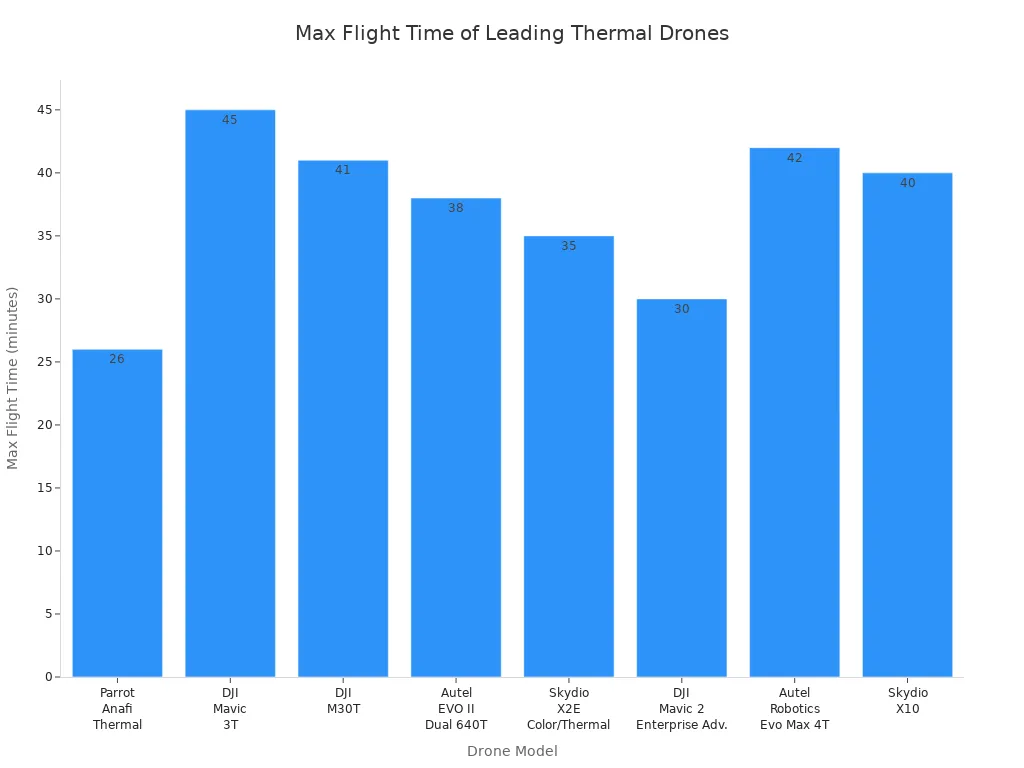
Integration and Compatibility
Check if your drone works with different infrared cameras or software. Some drones let you change sensors or add AI tools. This makes it easy to upgrade your thermal imaging as you need.
Price and Value
Thermal camera for drones can cost a lot. Expensive models have more features like weather resistance, real-time overlays, and strong data safety. Think about what features you really need. Sometimes, a mid-priced drone with good sensors and flight time is the best deal.
Use Case Fit
Match your drone’s features to your job. For farming, you want GPS autopilot and wide coverage. For inspections, look for gyroscopic stabilization and obstacle avoidance. For search and rescue, pick drones with AI and high thermal camera resolution for fast, safe results.
Tip: Always pick a drone with the right infrared sensors and thermal imaging for your main jobs. This helps you get the most for your money.
Best Thermal Imaging Drones Reviews
DJI Mavic 3T
The DJI Mavic 3T is small but powerful. It is one of the best thermal drones for 2025. This drone has a high-resolution thermal camera and a strong visual camera. It is great for search and rescue, inspections, and public safety. The Mavic 3T is light and folds up to fit in a bag. It can fly for up to 45 minutes. You can zoom in close with its 56x hybrid zoom. The 640×512 sensor gives you clear thermal images. The drone has sensors all around to avoid obstacles. RTK helps it fly in the right spot.
Specification Category | Details |
|---|---|
Aircraft Weight | 920 g (with propellers, no accessories) |
Max Flight Time | 45 minutes |
Max Flight Distance | 32 km |
Thermal Camera | 640×512 px resolution; 61° DFOV; 40 mm equivalent focal length |
Visual Camera | 48 MP, 1/2″ CMOS sensor |
Zoom | 56x hybrid zoom; 28x continuous digital zoom |
Transmission | Up to 15 km; 1080p/30fps live broadcast |
Safety Features | Omnidirectional obstacle sensing; DJI AirSense ADS-B; APAS 5.0 |
Pros:
Dual thermal and visual cameras
Long flight time
High-precision RTK
Advanced obstacle sensing
Compact and lightweight
Cons:
Not weatherproof (no IP rating)
Rolling shutter can affect photogrammetry
16-bit thermal image format not yet supported in app
Best Use Cases:
You can use the Mavic 3T for checking buildings, watching nature, and keeping people safe. It works best when the weather is good. If you need a drone that zooms in and is easy to carry, this is a smart pick.
Autel Robotics EVO Max 4T
The Autel EVO Max 4T is made for hard jobs. It has many cameras and a laser rangefinder. You get a 48MP zoom camera, a 50MP wide camera, and a 640×512 thermal camera. It can fly for up to 42 minutes and go as far as 20 km. The drone avoids obstacles in every direction. It uses special networking to talk to other drones.
Feature | Details |
|---|---|
Multi-sensor payload | 48MP zoom (10x optical, 160x hybrid), 50MP wide, 640×512 thermal, laser rangefinder |
Video capabilities | 8K HD video, up to 7680×4320 resolution |
Flight time | Up to 42 minutes |
Transmission range | Up to 20 km |
Obstacle avoidance | 720° omnidirectional with binocular vision and radar |
Networking technology | A-Mesh mesh networking for drone-to-drone communication |
GPS-denied navigation | SLAM technology |
Battery | Hot-swappable |
Data security | AES-256 encryption |
Pros:
Extended flight time
Advanced obstacle avoidance
Mesh networking for team missions
GPS-denied navigation
Hot-swappable batteries
No geofencing restrictions
Best for flexibility in tough environments
Cons:
Heavier than some competitors
Higher price point
Best Use Cases:
You can use the EVO Max 4T for keeping people safe, checking big buildings, and helping in emergencies. If you want a drone with lots of features and can handle hard work, this is a great choice.
DJI Matrice 350 RTK + Zenmuse H20T
The DJI Matrice 350 RTK with Zenmuse H20T is for big jobs. It gives very accurate RTK, a 640×512 thermal camera, and a 20 MP zoom camera. This drone can fly up to 20 km away. It works in very hot or cold weather. It is strong and made for long flights.
Feature | Specification |
|---|---|
RTK Positioning Accuracy | 1 cm + 1 ppm (horizontal), 1.5 cm + 1 ppm (vertical) |
Max Video Transmission Range | Up to 20 km |
Operating Temperature Range | -20°C to 50°C |
Wide Camera | 12 MP, 82.9° DFOV |
Zoom Camera | 20 MP, 23× hybrid optical zoom |
Thermal Camera | Radiometric, 640×512 px resolution |
Laser Rangefinder | 1200 m max range |
Pros:
High-precision RTK
Long-range and long flight time
Multi-sensor payload
Works in extreme weather
Best for pro-level industrial and emergency work
Cons:
Large and heavy
Expensive
Needs trained pilots
Best Use Cases:
You can use this drone for checking power lines, fighting fires, and finding lost people. If you need a strong drone for big jobs, this is a top pick.
DJI M30T
The DJI M30T is small but does a lot. It has three cameras: a 48MP zoom, a 12MP wide, and a 640×512 thermal camera. It can fly for up to 41 minutes and stays steady in strong wind. The drone is safe to use in rain and dust with its IP55 rating. It also has sensors to avoid obstacles and RTK for flying in the right place.
Feature / Use Case | Description | Benefits / Highlights |
|---|---|---|
Camera System | 48MP zoom, 12MP wide, 640×512 thermal | High-res imaging, thermal for inspections and rescue |
Flight Performance | 41 min max, wind resistance 15 m/s, 23 m/s speed | Long endurance, stable in tough weather |
Durability & Design | Foldable, ~3770g, IP55 | Portable, reliable in rain/dust |
Safety & Control Features | Omnidirectional sensing, RTK, emergency landing | Safer flights, precise navigation |
Transmission & Control | OcuSync 3 Enterprise, 15 km range, 7-inch touchscreen | Long-range, easy control |
Advanced Flight Modes | Waypoints, ActiveTrack, programmable paths | Smart, efficient missions |
Pros:
Triple camera system
Weather resistant (IP55)
Long flight time
Best for zoom and night operations
User-friendly controls
Cons:
Heavier than foldable drones
Higher cost
Best Use Cases:
You can use the M30T for checking bridges, finding people, and watching nature. If you want a drone that works in any weather and zooms in close, this is a good pick.
Autel EVO II Dual 640T
The Autel EVO II Dual 640T is great for thermal imaging at work. It has a 640×512 thermal sensor with 16x digital zoom and a strong camera. The drone uses AI to follow targets and check heat. It lets you measure heat in different ways and make reports right away.
Key Features:
640×512 thermal sensor with 13mm lens
16x digital zoom
AI-powered Dynamic Track 2.0
Advanced thermal measurement (spot, regional, central)
IRPC tool for data visualization and reporting
Rugged and durable design
Pros:
Dual sensor system
Smart AI features
Best for flexibility in industrial work
Detailed thermal analysis
Cons:
Not as compact as some models
Shorter flight time than larger drones
Best Use Cases:
You can use this drone for checking buildings, fighting fires, and farming. If you want a smart drone for thermal imaging, this is a great choice.
DJI Matrice 4T
The DJI Matrice 4T is made for safety and emergencies. It has a radiometric thermal sensor and a 48MP zoom camera. The drone can fly at night with an IR light. It uses AI to help follow things and is good for checking and watching.
Aspect | Advantages of DJI Matrice 4T | Limitations of DJI Matrice 4T |
|---|---|---|
Thermal Imaging | Radiometric sensor for firefighting, rescue, security, inspections | Only JPEG image format, no RAW support |
Camera System | 48 MP zoom camera for detailed inspection | Electronic shutter, less ideal for mapping |
Night Operations | IR illuminator for covert missions | Slower photo interval than Matrice 4E |
Image Capture Modes | High-Res Grid for better thermal detail | Not for high-precision mapping |
AI and Tracking | AI-assisted tracking, night scene capabilities | Less suited for rapid mapping |
Use Case Focus | Public safety, emergency, inspection, conservation | Not ideal for geospatial engineering |
Pros:
Strong thermal and visual cameras
Night operation ready
AI tracking
Best for pro emergency and safety work
Cons:
No RAW image support
Not for high-precision mapping
Best Use Cases:
You can use the Matrice 4T for fighting fires, police work, and watching animals. If you want a drone for safety jobs, this is a top choice.
Parrot Anafi USA
The Parrot Anafi USA is light and easy to carry. It has a FLIR Boson 320×256 thermal camera. You can find hot spots from 2 km away and see people from far. The 32x zoom and image stabilization help you see details. The drone is ready to fly in less than a minute and weighs only 500 grams. It keeps your data safe with strong encryption.
The Anafi USA is a good deal for fast use, clear thermal images, and long range. You can use it for fighting fires, finding people, and checking power lines. If you want a drone that is quick and flexible, this is a smart pick.
Yuneec H520E + E20TVX
The Yuneec H520E with E20TVX camera is built for power and balance. It can fly up to 65 minutes without extra weight and go as far as 15 km. The drone can carry up to 3 kg and works with all H520E cameras. It has two IMUs, RTK antennas, and can land safely with five motors.
Specification / Feature | Details |
|---|---|
Transmission Range | Up to 15 km with dual-frequency controller |
Flight Time | Up to 65 minutes (no payload) |
Payload Compatibility | All H520E payloads including E20TVX |
Payload Capacity | Up to 3000 grams |
Drone Design | Hexacopter for stability |
Safety Features | Dual IMUs, compass, barometer, dual RTK, two batteries, safe landing with 5 motors |
Use Scenarios | Inspection, surveying, public safety, rescue |
Data Security | Flight data privacy |
Pros:
Longest flight time in class
High payload capacity
Stable hexacopter design
Best for pro-level surveying and rescue
Cons:
Expensive
Heavier and larger than quadcopters
Best Use Cases:
You can use the H520E for mapping, checking buildings, and rescue work. If you want a drone that flies long and carries a lot, this is a top pick.
DJI Matrice 300 RTK + H20T
The DJI Matrice 300 RTK with H20T camera is best for big jobs. It goes up and down fast and flies up to 55 minutes. The drone can carry three cameras at once. It has sensors in six directions, IP45 weather protection, and two batteries for safety.
Key Features:
Up to 55 minutes flight time
2.7 kg payload capacity
RTK for centimeter-level accuracy
Six-directional obstacle sensing
IP45 weather rating
OcuSync Enterprise transmission (15 km range)
Triple payload support
Advanced dual pilot control
Pros:
Longest flight time
Multiple payloads
Best for pro industrial and emergency work
Reliable in harsh weather
Cons:
Large and heavy
High price
Needs experienced pilots
Best Use Cases:
You can use this drone for finding people, fighting fires, and big inspections. If you want the best drone for big jobs, this is the best pick.
Autel EVO II Dual 640T V3
The Autel EVO II Dual 640T V3 has new upgrades for thermal imaging. It has a 640×512 thermal camera with 16x digital zoom. The new software makes thermal images even clearer. The drone also has a 50MP camera for low-light shots. SkyLink 2.0 lets you fly up to 15 km and keeps the signal strong.
Pros:
High-definition thermal camera
Improved image clarity
Dual camera system
Best for zoom and low-light work
Long transmission range
Cons:
Not as rugged as some pro models
Shorter flight time than heavy-duty drones
Best Use Cases:
You can use the EVO II Dual 640T V3 for checking buildings, security, and flying at night. If you want a drone for zoom and clear thermal images, this is a top choice.
Thermal Drones Comparison Table
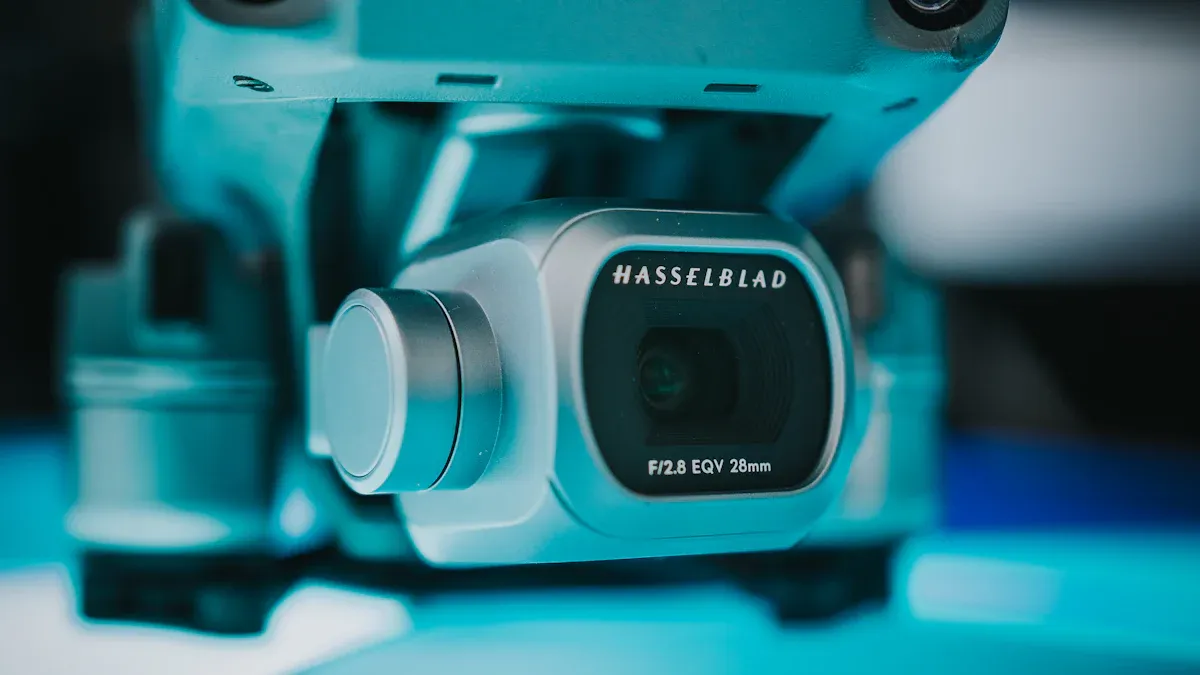
Picking the right thermal drone can be confusing. It helps to see how the top drones compare. Here’s a table that shows the main features of the best drones in 2025:
Feature / Model | Matrice 4T / Matrice 30T | Mavic 3 Enterprise Thermal (M3T) / Mavic 3 Enterprise (M3E) | Legacy Models (Mavic 2 Enterprise Advanced) |
|---|---|---|---|
Radiometric thermal camera 640×512 @ 30 Hz | Radiometric thermal camera, lower zoom (4× optical, 56× hybrid) | 640×512 thermal sensor (M2E Advanced), lower flight time | |
Optical Zoom | Up to 16× optical, 128× hybrid zoom | 4× optical zoom, 56× hybrid zoom | 2× optical zoom (M2E Zoom), less advanced |
Flight Time | Longer flight times (superior) | ~45 minutes | Shorter flight times |
Weather Resistance | IP55 ingress protection, weatherproof | No rainproofing, less weather resistant | Less weather resistant |
Portability | Larger, heavier, higher cost | Smaller, lighter, more portable | Older, less portable |
Specialized Use Cases | High-detail inspections, telecom towers, public safety, search & rescue with AI, loudspeaker, spotlight | Routine inspections, quick deployment, situational awareness | Basic thermal capability, phased out |
Camera System | Advanced multi-camera gimbal, 48MP sensors, stabilized zoom | Dual camera setup, less advanced zoom and sensors | Dual thermal/visible sensors, less advanced optics |
💡 Tip: If you need a drone for hard jobs or bad weather, the Matrice series is best. It gives you clear thermal images, strong zoom, and special tools. You can use it for big checks or rescue work. If you want something small and easy to carry, the Mavic 3 models are good for fast checks and simple safety jobs.
Matrice drones are great when you need the best features. They work in rain, wind, and tough places. You get strong zoom and clear thermal pictures. The Mavic 3 series is good if you want to move fast and keep things easy. These drones cost less and are simple to use. You can use many at once if you have a team. Older drones like the Mavic 2 Enterprise Advanced do not have the newest tech, so most people now pick the latest models.
When you look at this table, think about your main job. Do you need to fly in bad weather or zoom in close? Or do you want something light and fast for daily work? This table helps you find the right drone for your needs.
How to Choose the Best Thermal Drones for Your Needs
Agriculture
If you work on a farm, you need a drone that checks crops fast. Pick one with a high-resolution thermal camera, like 640×512. Long flight time helps you cover more land. Strong wind resistance keeps the drone steady outside. Drones with both thermal and RGB cameras show more details. Small farms can use light drones. Big farms need fixed-wing drones that fly farther.
Feature | Why It Matters for Agriculture |
|---|---|
High-res thermal camera | Helps you see crop stress and water problems |
Long flight time | Lets you check more fields in one trip |
Zoom | Makes it easy to look at plants up close |
Wind resistance | Keeps the drone steady in windy fields |
Dual cameras | Shows both heat and color pictures |
Some good choices are Autel EVO II Dual 640T for medium farms, Parrot Anafi Thermal for small farms, and Quantum Trinity F90+ for big fields. These drones make checking crops quick and simple.
Industrial Inspection
You need a drone that takes clear pictures and stays steady. Choose one with at least 320×240 thermal resolution, but 640×512 is even better. RGB cameras help you see more. Features like GPS hold, obstacle avoidance, and batteries that last over 30 minutes make work easier.
Autel EVO II Dual 640T V3: Good for new users and experts.
DJI Mavic 3T: Flies long and takes sharp pictures.
Parrot Anafi USA Thermal: Tough and simple to use.
FLIR SIRAS: Great for hard jobs.
Use software that works with your drone for better reports. Always check the rules before you fly.
Search and Rescue
Thermal drones help you find people fast, even at night or in smoke. You want high thermal resolution, long flight time, and strong obstacle avoidance. Drones like the Autel Robotics Evo Max 4T, DJI Mavic 3T, and DJI M30T are top picks.
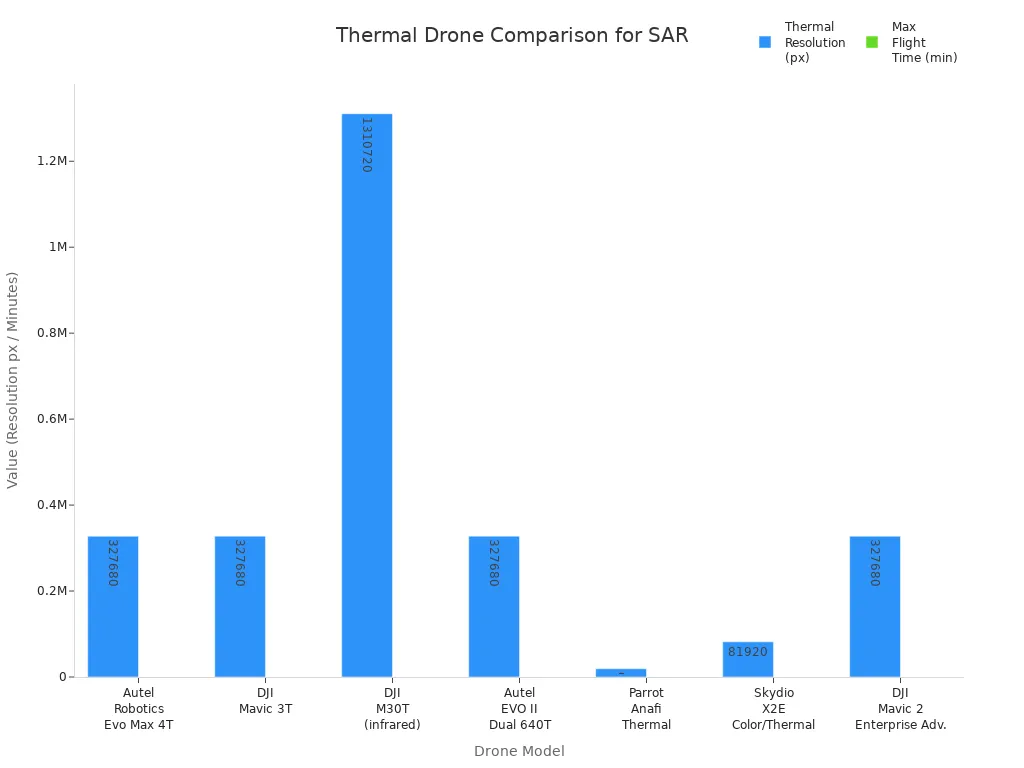
These drones spot heat quickly and fly safely in tough places. The right drone can help save lives.
Firefighting
For firefighting, you need a tough drone with live HD video and strong thermal imaging. Look for weather resistance, long battery life, and quick setup. The DJI Matrice 350 RTK, Skydio X10, and FLIR SIRAS are great choices.
Drone Model | Flight Time | Durability | Special Features |
|---|---|---|---|
DJI Matrice 350 RTK | 55 min | IP55 | Flies far, carries many tools |
Skydio X10 | 45 min | IP54 | AI flying, works at night |
FLIR SIRAS | 31 min | IP54 | Change batteries fast, has radar |
These drones help you see through smoke, find hot spots, and keep teams safe. You can trust them in tough weather.
Wildlife Monitoring
Thermal drones help you track animals, even at night. You need a drone for the environment that uses smart detection. Drones with high accuracy, like those using YOLO-MFP, find small animals and miss less. You can watch wildlife without bothering them and get good data for research.
Security and Surveillance
For surveillance, you need a drone with good cameras, long battery life, and weather resistance. Dual cameras (thermal and RGB) help you see heat and details. Models like the DJI Mavic 2 Enterprise Advanced and DJI Matrice 30T work well. They set up fast, zoom in close, and keep your data safe. Always think about weather and time of day for best results.
Tip: Pick a drone with features that fit your main job. If you need a drone for firefighting or surveillance, choose one with the right camera, flight time, and safety tools. This helps you get the best results, whether you are new or experienced.
Thermal Imaging Drones: Regulations and Tips
Legal Considerations
Before you fly your thermal drone, you need to know the rules. The FAA sets the main laws for drones in the United States. These rules help keep everyone safe and protect the airspace. Here’s what you should remember in 2025:
You must follow FAA Part 107 rules for commercial drone flights. These rules cover speed, safe flying, and where you can fly.
Every drone needs Remote ID. This means your drone must broadcast its ID and location while flying. There are only a few exceptions, like flying in special FAA areas.
You can fly at night or over people if you finish the right training and use the right equipment.
If you want to fly in controlled airspace, you need special permission. This includes night flights.
New rules for BVLOS (Beyond Visual Line of Sight) flights may arrive soon. These could let you fly farther if your drone has special safety systems.
Some states and the federal government are working on ways to stop bad drones. You should always follow local laws.
Register your drone. It costs $5 for three years. Always carry proof of registration when you fly.
The FAA checks for rule-breakers more often now. If you follow the rules and work with local officials, you will avoid trouble.
There are no extra rules just for thermal drones. All drones must follow the same laws.
Tip: Always check for updates before you fly. Rules can change fast!
Operational Best Practices
You want your flights to be safe and your images to be clear. Here are some best practices for using thermal drones:
Plan your mission. Know your area, check the weather, and set your flight path.
Inspect your drone. Look for damage, check the battery, and make sure the camera works.
Update your software. Use the latest firmware for your drone and camera.
Fly safely. Avoid crowds, respect privacy, and keep your drone in sight unless you have BVLOS approval.
Use the right settings. Adjust your thermal camera for the job. Try different color palettes and temperature ranges.
Keep records. Log your flights, save your images, and note any problems.
Respect wildlife and property. Don’t disturb animals or fly over private land without permission.
🛡️ Note: Good habits keep you safe and help you get the best results from your thermal drone.
You now know the best thermal drones for 2025. Each model stands out with strong cameras, long flight times, and smart features. Use the buying guide and comparison table to match a drone to your needs and budget.
Check for new updates and read user reviews.
Ask experts if you need help with special jobs.
Ready to pick your drone? Take the next step and choose with confidence!
FAQ
What is a thermal drone camera used for?
You can use a thermal drone camera to spot heat. It helps you find people, check buildings, watch wildlife, and look for fires. Farmers use it to check crops. It works in the dark or through smoke.
Can I fly a thermal drone at night?
Yes, you can fly at night if you follow FAA rules. You need special training and lights on your drone. Always check local laws before you fly after dark.
How long does a thermal drone battery last?
Most thermal drones fly for 30 to 55 minutes on one battery. Wind, weight, and cold can make the battery run out faster. Always bring extra batteries for longer jobs.
Are thermal drones waterproof?
Some thermal drones can handle rain or dust. Look for an IP rating like IP45 or IP55. If your drone does not have this, keep it dry and safe from water.
Do thermal cameras work in fog or smoke?
Thermal cameras can see heat through light fog or smoke. Thick fog or heavy smoke can block the view. You still get better results than with normal cameras.
Tip: Always test your drone in safe conditions before using it for important work!
See Also
The Importance Of Thermal Imaging Cameras In 2025
Guide To Operating Thermal Cameras For Rescue Missions 2025
Vanadium Oxide Based Thermal Cameras Designed For Rescue
